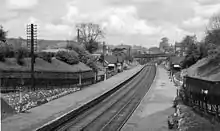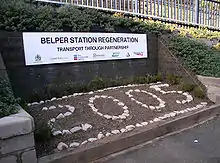Belper railway station
Belper railway station serves the town of Belper in Derbyshire, England. The station is located on the Midland Main Line from Derby to Leeds, 135 miles 55 chains (218.4 km) north of London St Pancras.
 Belper station, 2005 | |
| Location | Belper, Amber Valley England |
| Grid reference | SK348475 |
| Managed by | East Midlands Railway |
| Platforms | 2 |
| Other information | |
| Station code | BLP |
| Classification | DfT category F1 |
| History | |
| Opened | 1840 |
| Passengers | |
| 2015/16 | |
| Interchange | |
| 2016/17 | |
| Interchange | |
| 2017/18 | |
| Interchange | |
| 2018/19 | |
| Interchange | |
| 2019/20 | |
| Interchange | |
| Notes | |
Passenger statistics from the Office of Rail and Road | |
Description
Access to the station can be gained via a narrow alleyway from King Street beside the Poundland store, from the Field Lane car park and across the rear of the supermarket, from Bridge Street via Wellington Court and via alleyways from Field Lane (by the railway bridge) and Albert Street.
The station is served by one operator, East Midlands Railway, with local services from Newark Castle via Nottingham and Derby to Matlock along the Derwent Valley Line. Services are approximately hourly Monday to Saturday, two-hourly on Sundays, and are formed using diesel multiple units of Classes 153, 156 or 158. A few early and late trains start/terminate at Nottingham or Derby rather than Newark Castle.[1]
A single weekday return journey to/from Sheffield is also provided, departing Belper at 07:29 and returning at 18:06.[2]
Interchange with services to many local and national destinations including Leicester, Leeds, Sheffield, Birmingham and London can be made at Derby or Nottingham.
History



The line was surveyed by George Stephenson for the North Midland Railway Company, and opened in 1840. The Strutt family who had built cotton mills and had become the primary landowner, were great supporters of the line and had invested in it. They feared, however, that it would interfere with the water supply to the mill and affect both theirs and their employees' livelihood, so initially suggested in 1835 that the line should proceed by Holbrook.[3]
This proved unsatisfactory and, in the 1836 Act authorising the line, the proposed route took it to the east of the Derwent through Milford then to the west past Belper. This "Milford Deviation" was still not acceptable, so a revised Act was approved in 1837.
This entailed the building of Milford Tunnel and entailed a long cutting, at enormous (and unexpected) expense, with eleven bridges in the space of a mile.[4] The cutting, lined with gritstone, is now a grade 2 listed building.
North of Belper, the engineers paid the penalty of following a river valley, with two long bridges over Belper Pool, plus two more, before reaching Ambergate.
The original station was built on the south side of Belper, just before the cutting, designed by Francis Thompson in an Italianate design. A coach, or omnibus, ran regularly to it from the Lion Hotel in Bridge Street. However this proved so unpopular that the Midland Railway built a new station in 1878 within the cutting, at the town centre, next to King Street. This had platforms with access ramps for each of the two lines, both provided with waiting rooms, in the standard Midland Railway design. The booking office and other facilities were at street level. Since the new station lacked sidings, the old station remained in use for many years for the processing of goods traffic.
Originally the station was a stop on the Midland Railway's main line from London St Pancras to Manchester Central which travelled through the Peak District.
When this line was truncated to its present terminus at Matlock in the late 'sixties and following withdrawal of the Manchester trains, the station became unmanned and in 1973 the station buildings were demolished. The bridge carrying King Street over the line was widened to make room for a number of shops, including a supermarket which was originally Fine Fare and has subsequently had a number of occupiers, currently Poundland.
In 2005 the station was refurbished with new shelters, seats, train indicators and rubbish bins by a consortium of local volunteers, work experience trainees provided by The Groundwork Trust and the local councils, with the active support of Network Rail and Central Trains (who managed the station at that time). In April 2012 a group called Transition Belper adopted the station with the help of the Derwent Valley Line Community Rail Partnership, East Midlands Trains, Network Rail and Belper Town Council.[5]
During June–July 2009, an automatic ticket machine was installed on the Derby-bound platform. This enables passengers to buy tickets (or collect those purchased in advance) before they board. In December 2009, Belper became a Penalty fare station. The penalty fare applies for any southbound travel or on northbound mainline services. Ambergate to Matlock is not part of the penalty fare scheme. Where the local authority provides a discount, if the vending machine is unable to issue them, they are then bought on the train. The notices at the station, however, give the impression that penalty fares are applicable to all destinations.
Stationmasters
- Mr. Eden ca. 1865
- John Orton ca. 1874
- Samuel Buxton 1875 - 1881
- William Henry Buxton 1881 - 1896[6] (afterwards station master at Lincoln)
- Richard William Mapp ca. 1897 - 1901 (afterwards station master at Gloucester)
- Thomas Pitt 1901 - 1905 (afterwards station master at St Albans)
- Henry Merryweather 1905 - 1924[7]
- William Washbourne 1924 - ????
- Arthur H. Washbourne ca. 1934
- Henry Foster 1938 - 1947[8]
- Edmund T. Jackson 1947 - 1955[9] (formerly station master at Spondon)
Notes
- "Timetable from May 2016" (PDF). East Midlands Trains. May 2016. Archived from the original (PDF) on 12 October 2016. Retrieved 23 June 2016.
- "New train after passenger boom". belpernews.co.uk. Archived from the original on 6 May 2016. Retrieved 31 May 2014.
- World Heritage News, Issue 14, 2014, Derwent Valley Mills Partnership
- Stroud, Gill (2004). "Derbyshire Extensive Urban Survey Archaeological Assessment Report - Belper" (PDF). p. 8. Retrieved 23 August 2012.
- [Transition Belper - Adopting Belper Railway Station http://www.transitionbelper.org/train%20station.html]
- "Complimentary Banquet and Presentation to the Late Belper Station Master". Long Eaton Advertiser. England. 4 April 1896. Retrieved 24 January 2021 – via British Newspaper Archive.
- "Belper & District Topics". Derbyshire Times and Chesterfield Herald. England. 24 May 1924. Retrieved 24 January 2021 – via British Newspaper Archive.
- "Stationmaster at Belper". Derby Daily Telegraph. England. 27 August 1947. Retrieved 24 January 2021 – via British Newspaper Archive.
- "48 years' service. Belper Stationmaster Retires". Belper News. England. 25 November 1955. Retrieved 24 January 2021 – via British Newspaper Archive.
References
- Pixton, B., (2000) North Midland: Portrait of a Famous Route, Cheltenham: Runpast Publishing
- The North Midland Railway Guide, (1842) Republished 1973, Leeds: Turntable Enterprises
- Naylor, P. (Ed) (2000) An Illustrated History of Belper and its Environs Belper: M.G.Morris
External links
| Wikimedia Commons has media related to Belper railway station. |
- Train times and station information for Belper railway station from National Rail
- "Picture the Past" Original Station at Belper
- "Picture the Past" Belper Station circa 1910
- "Picture the Past" Station building c.1955
| Preceding station | Following station | |||
|---|---|---|---|---|
| East Midlands Railway Derwent Valley Line | ||||
Limited Service | Limited Service |
